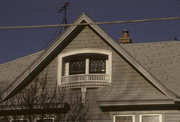| Additional Information: | 2013: Frederick N. Appleyard, who at times worked as a carpenter and real estate broker, had constructed a modestly sized, two-and-one-half story home around 1908 at the northwest corner of North Main Street and Bent Avenue, next door to the home that was concurrently being constructed for his son, Martin. The Appleyard homes were the first two homes constructed in the district. Soon after moving to North Main Street, Frederick began a company manufacturing cement blocks under the name Appleyard Cement Works; and from approximately 1914 to 1919, the company operated at a vacant lot within the district at 1537 North Main Street. However, by 1922, he began working as a foreman for the Royal Machine & Foundry Company, owned by his neighbor, Peter J. Schloemer.
The Frederick N. & Henrietta Appleyard House is generally rectangular in plan with the exception of a projecting bay window on the south side façade near the back corner. The exterior of the building is largely covered with wooden clapboards and features a wide wooden skirt board above the roughly-cut stone foundation. On the front façade at first floor level, an entry door is situated right of center with a wide, shallow bay containing a central fixed and flanking double-hung replacement windows comprising the entirety of the façade to the left of the entry door. A small, square replacement window is situated to the right of the entry door. The building’s first floor-level windows and front entry door are trimmed with a simple wooden crown. Two pairs of double-hung replacement windows divide the front façade into thirds at the second floor level, the tops of which abut a wooden frieze board. The main block of the house is covered by a steeply-pitched side-gabled roof with moderately wide overhanging eaves and clipped gable ends. The two side gable ends each contain a pair of double-hung replacement windows. An intersecting cross gable is centered on the front and features a segmental arched recess, the interior of which is clad with clapboard and contains a pair of double-hung replacement windows. The recess also features a short, wooden balustrade, denticulated wooden sill, and a prominent, inverted wooden post ornament hanging below the sill. The home features a flared attic floor level that acts as a pent roof with moderately wide overhanging in the gable ends above which the gable ends are clad in staggered wooden shingles, this flared pent roof is interrupted at the center of the front gable. The shallow projecting bay on the south façade near the back corner features a double-hung replacement window in each of its three faces and is covered by a shallow-pitched hipped roof with moderately wide overhanging eaves. A full-length porch shelters the front entry door. The porch is supported by three roughly-cut stone piers, one at each corner and the center, which above each is a fluted column, supporting the porch’s shallow-pitched gabled roof with moderately wide overhanging eaves whose front gable end is clad in staggered wooden shingles. A non-original metal railing has been installed along the outer edges of the porch, between each column, and alongside the porch steps that are located to the right of the center column.
GABLE WALL DORMER, WOOD SHINGLES IN GABLE ENDS, QUEEN ANNE WINDOW.
Resurveyed: "N. Main Street Survey," WisDOT ID #4994-01-14/15, Prepared by Heritage Research (2013). |
|---|
| Bibliographic References: | Oshkosh City Directories, Various Years 1900-1960. On file at the Oshkosh Public Library, Oshkosh, Wisconsin.
City of Oshkosh Assessment Data. City of Oshkosh website. <http://www.ci.oshkosh.wi.us> Accessed Nov. 6, 2012.
"N. Main Street Survey," WisDOT ID #4994-01-14/15, Prepared by Heritage Research (2013). |
|---|





